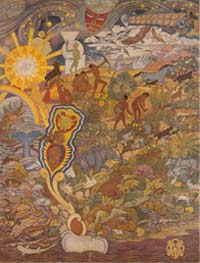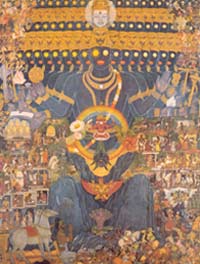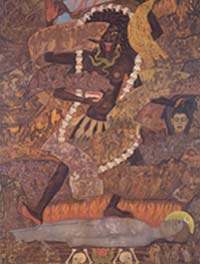


Alice Boner (1889-1981) was a Swiss artist and scholar of Indian art who had made Varanasi her home from 1936 to 1978. Trained as a sculptor and with an early interest in Indian art, she came in contact with the dancer Uday Shankar in 1927. In 1930 she traveled with him to India for the first time to organise his dance troupe. This was also the occasion for her discovery of Kathakali. She was instrumental in making these art forms known. When Uday Shankar and his troupe settled in Paris she managed and supported them for five years. She recalls that "this was indeed a direct, vital and effective introduction to India and her colorful life."
In 1935 she moved to India and chose to live in an old house on the Assi Ghat in Varanasi, where instead of sculpture she took to painting. Her themes were the scenes and the people she observed around her and also mythological subjects. She devoted many years to complete her masterpiece, the triptych Sristi-Sthiti-Samhara, also called Prakriti- Visvarupa-Kali. A number of sketches preceded the final form of these three paintings.
About the origin of the Tryptych she writes in her diary:
'It was as if out of my own subconscious the entire creation wanted to break forth. All what I ever had seen or heard, or felt, or thought, all perceptions and feelings were assuming now definite visible and plastic shapes, thus freeing themselves from the dump prison of the Unconscious. It was the whole of Prakrti which I felt flowing from myself.
At the time when these visions occurred to me I still felt my means of expression utterly inadequate to translate them into painting. Yet these visions had left a deep impression. There was no getting away from them.
During this period the conception of Krishna- Visvarupa from the Bhagavad Gita started emerging in my mind. Eventually, the figure of Krishna supporting the whole universe appeared to me as a possible link between the two other subjects of Creation and Destruction. Finally,I began working
out the compositions of both Visvarupa and Prakrti.
However, she devoted most of her time to the study of Indian culture, art, religion and philosophy as well as Sanskrit. She was in contact with all the great scholars and artists of the time, with the poets Rabindranath Tagore, Vallathol Narayan Menon and Sarojini Naidu, with the art-historians Rai Krishnadasa, Vasudeva Sharan Agrawala, Stella Kramrisch, and others, with musicians like Ustad Allaudin Khan, dancers and Kathakali performers.
She used to spend many months in the cave-temples of Ellora, studying the sculptures. This meditation led her to a monumental discovery related to the "Principles of Composition in Hindu Sculpture" (title of her book). In her own words :
'It Was before the magnificent panels carved inside the Cave-temples of Elura, that in 1941. I had the first intuitive perception of a deliberate compositional planning. Day after day I sat in front of these images, lost in contemplation, passively allowing their mysterious presence to penetrate my inner perception. I had done this for some time when all of a sudden one of the images, the Visnu Trivikrama in Cave XV, began to resolve its formcontext into a kind of geometrical pattern woven in rhythms of abstract lines, as though it were its subtle body containing its substance in sublimated form. I felt that here might be the clue to the mystery that lay hidden below the surface of these images. But the number of sculptures that revealed such patterns soon became quite impressive. I gained the conviction that they had a definite purpose and represented the compositional build-up of the sculptures.'
Her deep insight into the fundamental form principles of Indian art was later confirmed by texts of the Silpa- Vastu traditions. In search of traditional silpis and, sthapatis as well as unpublished texts, she came to Orissa and met Pandit Sadasiva Rath Sarman in Puri. He was also a traditional artist and he could understand what she was searching for. They started a long collaboration in editing, translating and illustrating texts on temple architecture and sculpture of .
Orissa. The outcome were the following publications : Silpa Prakasa, Leiden, 1966
New Light on the Sun Temple of Konarka, Varanasi, 1972
Vastusutra Upanisad (ed. by Bettina Baumer) Delhi 1982 (rev. ed. 1997)
In Orissa Alice Boner found a living tradition as well as rich artistic and religious heritage and she devoted the last 20 years of her life to its study. She became a pioneer in the study of so far neglected Silpasastras which offer a key to the understanding of Indian art in its own terms.
Alice Boner was awarded an honorary Doctorate from the University of Zurich, and in 1974 the Government of India bestowed on her the Padma Bhushan for her outstanding contribution to the understanding of Indian art.
The Alice Boner Gallery was set up with the assistance of the Alice Boner
Foundation in 1989 to mark the birth centenary of Alice Boner. It has
been designed by Amardeep Behl (Oriole Design, New Delhi) and coordinated
by Dr. Bettina Baumer .
The Gallery is designed like a mandala and it leads the visitor through the various phases in Alice Boner's life: Sculpture, Dance (Uday Shankar and Kathakali), Painting, culminating in the central Triptych, her collections of Indian stone sculptures and terracotta donated to Bharat Kala Bhavan, her scholarly work, and illustrated palm leaf manuscripts which she used for her publications. The exhibits are accompanied by quotations from her books and diaries and introductory texts as well as historical photos.
The notable exhibits in the gallery are the large size paintings by Dr. Alice Boner herself like Prakriti {creation), Visvarupa (preservation), Samhara Kali {Destruction) in centre, Mother Earth, Women in a shady lane, Crying child, Procession, Sunrise on the Ganges, Sitar Player, Vishnu Anantasayi on the rear side. A few interesting bronzes on view are Water carrier, Dance postures of Udai Shankar and a Female flute player. The gallery also displays some antique items like stone sculptures, terracottas and palm leaves illustrating Orissan temple architecture.


